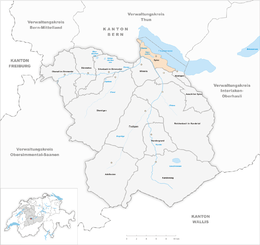Faulensee
| Spiez | ||
|---|---|---|
 |
||
|
||
| Coordinates: 46°41′N 7°40′E / 46.683°N 7.667°ECoordinates: 46°41′N 7°40′E / 46.683°N 7.667°E | ||
| Country | Switzerland | |
| Canton | Bern | |
| District | Frutigen-Niedersimmental | |
| Government | ||
| • Executive |
Gemeinderat with 7 members |
|
| • Mayor |
Gemeindepräsident Franz Arnold SPS/PSS (as of 2002) |
|
| • Parliament |
Grosser Gemeinderat with 36 members |
|
| Area | ||
| • Total | 16.69 km2 (6.44 sq mi) | |
| Elevation (Railway station) | 628 m (2,060 ft) | |
| Population (Dec 2015) | ||
| • Total | 12,477 | |
| • Density | 750/km2 (1,900/sq mi) | |
| Postal code | 3700 | |
| SFOS number | 0768 | |
| Localities | Einigen, Hondrich, Faulensee, and Spiezwiler | |
| Surrounded by | Aeschi bei Spiez, Hilterfingen, Krattigen, Oberhofen am Thunersee, Reutigen, Sigriswil, Thun, Wimmis, Zwieselberg | |
| Twin towns | Prachatice (Czech Republic) | |
| Website |
http://www.spiez.ch SFSO statistics |
|
Spiez is a town and municipality on the shore of Lake Thun in the Bernese Oberland region of the Swiss canton of Bern. It is part of the Frutigen-Niedersimmental administrative district. Besides the town of Spiez, the municipality also includes the settlements of Einigen, Hondrich, Faulensee, and Spiezwiler.
The official language of Spiez is (the Swiss variety of Standard) German, but the main spoken language is the local variant of the Alemannic Swiss German dialect.
Spiez is first mentioned around 761-62 as Spiets.
The area between the Kander and Lake Thun in modern Spiez was home to several large Bronze and Iron Age settlements. Three separate Bronze Age cemeteries with numerous graves contained a wealth of bronze axes, knives and cloak pins from 1750 to 1500 BC. On a nearby hill, the Bürg site is slightly younger and contained knives, arrow and spear heads, a horse's bridle and a razor. The Eggli hill top was apparently a religious site during the Bronze and Iron Ages. The center of the religious site was a granite block surrounded by ash from fires and thousands of shattered ceramic fragments. The Eggli site was probably used from about 1500 until 500 BC. Celtic graves from the 4th to 2nd century BC contained gold, amber and glass ornaments which were imported from over the Alps. A rare funerary urn was buried at Faulensee during the 1st century BC.
During the Roman era there was no permanent settlement in the area, but some Roman coins and Roman graves have been discovered. After the fall of the Western Roman Empire and into the Early Middle Ages the Spiez area was home to several scattered settlements. According to Elogius Kiburger, the author of the Strättliger Chronicle, in 933 the King of Burgundy, Rudolph II, built Spiez Castle. Shortly thereafter, the Freiherr von Strättligen settled in the castle. Portions of the current castle shield walls and main tower were built during the 12th century and by the 13th century the town of Spiez existed outside the castle walls. By 1280 the castle was listed as an Imperial fief under Vogt Richard von Corbières. In 1289 the Freiherr von Strättligen was co-owner of the castle along with a succession of other noble families. In 1308 King Albert I of Habsburg was murdered at Windisch on the Reuss, by his nephew Duke John Parricida. As part of their retaliation for the murder, the Habsburgs withdrew half of the Speiz fief from Thüring von Brandis and granted the whole fief to Johannes von Strättligen. Thirty years later, in 1338, Johannes sold the castle, town, church and surrounding villages to Johann II von Bubenberg who was the Schultheiss of Bern. By 1340, the Bubenberg appointed vogt took orders from Bern, but was obligated to raise troops for the Habsburgs. As Bern was de facto independent from their former overlords, the Habsburgs, this created an unstable situation which remained for over 40 years. After the Bernese and Swiss Confederation victory over the Habsburgs in the Battle of Sempach in 1386, the Habsburgs gave up their land claims west of the Aare, which included Speiz.
...
Wikipedia




